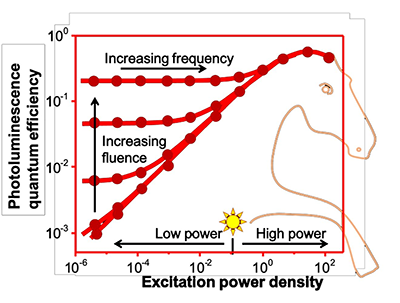| Jun 07, 2021 |
Lead halide perovskites - a horse of a different color
(Nanowerk News) In a joint experimental and theoretical effort between Lund University (Sweden), the Russian Academy of Science (Russia), and the Center for Advancing Electronics Dresden at Technische Universität Dresden (Germany), researchers developed a novel spectroscopic technique for the study of charge carrier dynamics in lead halide perovskites - publication in Nature Communications ("Are Shockley-Read-Hall and ABC models valid for lead halide perovskites?").
|
|
Metal halide perovskites have been under intense investigation over the last decade due to the remarkable rise in their performance in optoelectronic devices such as solar cells or light-emitting diodes.
|
|
Despite tremendous progress in this field, many fundamental aspects of the photophysics of perovskite materials remain unknown, such as a detailed understanding of their defect physics and charge recombination mechanisms. These are typically studied by measuring the photoluminescence – i.e. the emission of light upon photoexcitation – of the material in both the steady-state and transient regimes.
|
|
While such measurements are ubiquitous in literature, they do not capture the full range of the photophysical processes that occur in metal halide perovskites and thus represent only a partial picture of their charge carrier dynamics.
|
|
Moreover, while several theories are commonly applied to interpret these results, their validity and limitations have not been explored, raising concerns regarding the insights they offer.
|
|
To tackle this challenging question, a trinational team of researchers from Lund University (Sweden), the Russian Academy of Science (Russia) and the Technical University of Dresden (Germany) have developed a new methodology for the study of lead halide perovskites.
|
|
This methodology is based on the complete mapping of the photoluminescence quantum yield and decay dynamics in the two-dimensional (2D) space of both fluence and frequency of the excitation light pulse. Such 2D maps not only offer a complete representation of the sample’s photophysics, but also allow to examine the validity of theories, by applying a single set of theoretical equations and parameters to the entire data set.
|
|
“Mapping a perovskite film using our new method is like taking its fingerprints - it provides us with a great deal of information about each individual sample.” says Prof. Ivan Scheblykin, a Professor of Chemical Physics at Lund University. “Interestingly, each map resembles the shape of a horse’s neck and mane, leading us to fondly refer to them as ‘perovskite horses’, which are all unique in their own way.”
|
 |
| The diagram depicts a typical 2D photoluminescence map that resembles the shape of a horse’s neck and mane.
|
|
“The wealth of information contained in each 2D map allows us to explore different possible theories that may explain the complex behavior of charge carriers in metal halide perovskites” adds Dr. Pavel Frantsuzov from the Siberian Brunch of the Russian Academy of Science.
|
|
Indeed, the researchers discovered that the two most commonly applied theories (the so called ‘ABC theory’ and the Shockley-Read-Hall theory) cannot explain the 2D maps across the entire range of excitation parameters. They propose a more advanced theory that includes additional nonlinear processes to explain the photophysics of metal halide perovskites.
|
|
The researchers show that their method has important implications for the development of more efficient perovskite solar cells. Prof. Dr. Yana Vaynzof, Chair for Emerging Electronic Technologies at the Institute for Applied Physics and Photonic Materials and the Center for Advancing Electronics Dresden (cfaed) explains: “By applying the new methodology to perovskite samples with modified interfaces, we were able to quantify their influence on the charge carrier dynamics in the perovskite layer by changing, for example, the density and efficacy of traps. This will allow us to develop interfacial modification procedures that will lead to optimal properties and more efficient photovoltaic devices.”
|
|
Importantly, the new method is not limited to the study of metal halide perovskites and can be applied to any semiconducting material. “The versatility of our method and the ease with which we can apply it to new material systems is very exciting! We anticipate many new discoveries of fascinating photophysics in novel semiconductors.” adds Prof. Scheblykin.
|

